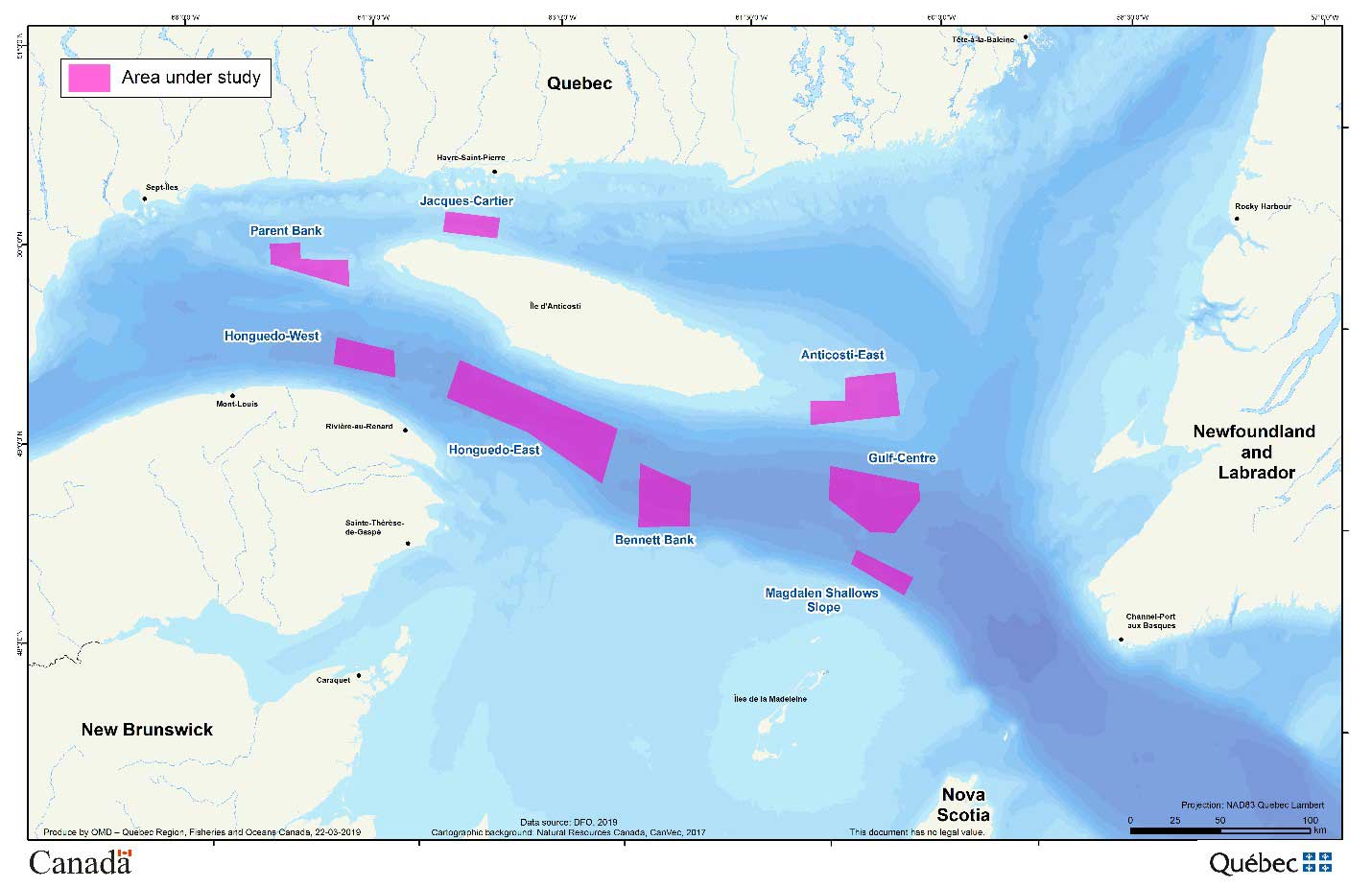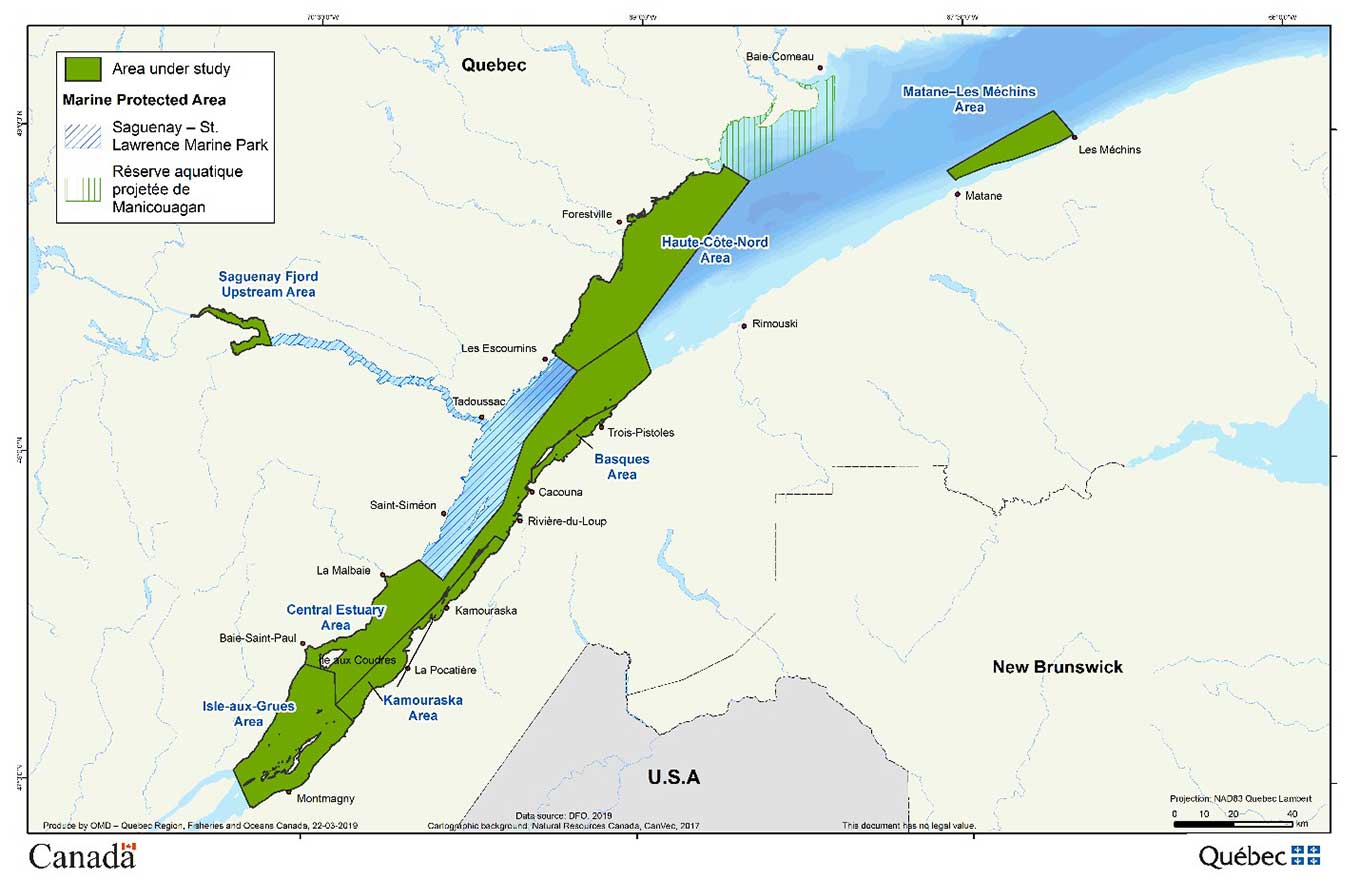Protection of the marine environment under the Canada-Quebec Collaborative Agreement
The Canada–Quebec Collaborative Agreement to Establish a Network of Marine Protected Areas in Quebec was announced in June 2018 (available in French). Under this agreement, all marine protected area projects in Quebec will be jointly selected, planned and implemented. Joint planning has been developed for Quebec marine protected area projects to be implemented in the coming years. The Banc-des-Américains Marine Protected Area is the first project to be included in this collaboration.
Projects under study
Projects under study
The following 2 projects are currently under study:
These projects are the result of analyses of important biological components (such as the presence of species at risk, feeding areas, fragile ecosystems, and breeding areas) in view of the conservation priorities determined by the governments. Furthermore, the projects take into account the representativeness of the different habitat types found in the Estuary and Gulf of St. Lawrence.
Work plan
In the spring and summer of 2019, the 2 projects were presented to Indigenous groups and relevant stakeholders.
In the coming months, conservation measures will be developed for each project and discussed with Indigenous groups and relevant stakeholders. Consultation on each project will then follow.
Steps completed
| Date (YYYY-MM-DD) | Location | Mode of communication | Details |
|---|---|---|---|
| 2020-11-18 | Videoconference | Information session with Mi'gmawe'I Tplu'taqnn Inc. | Presentation of projects (PDF) |
| 2019-11-28 | Bécancour, QC | Information session with the Navigation Coordination Committee (NCC) | Not available |
| 2019-11-04 | Quebec city, QC | Information session with Stratégies Saint-Laurent | Presentation of projects (PDF, in French only) |
| 2019-10-30 | Videoconference | Table environnement Côte-Nord | Presentation of projects (PDF, in French only) |
| 2019-09-19 | Les Escoumins, QC | Saguenay–St. Lawrence Marine Park Coordination Committee | Presentation of projects (PDF, in French only) |
| 2019-06-19 | Quebec city, QC (and via videoconference) | Stakeholder information session | Presentation of projects (PDF) |
| 2019-06-17 | Quebec city, QC (and via videoconference) | Information session with Indigenous groups | Presentation of projects (PDF) |
| 2019-07-10 | Videoconference | Liaison Committee between Fisheries and Oceans Canada and the Quebec Harvesting Sector | Presentation of projects (PDF) |
| 2019-08-08 | Non applicable | Information letter to indigenous groups and relevant stakeholders in the Gulf of St. Lawrence region and Newfoundland and Labrador | Not available |
For further information contact us at:
Email: Oceans-QC@dfo-mpo.gc.ca
Phone: 1 877 775-0848
Northern Gulf of St. Lawrence
Northern Gulf of St. Lawrence
Conservation priorities
Increase the protection of cold-water corals and sponges and the ecosystems that support them by regulating all activities that may have an impact on the seabed in 8 of the 11 marine refuges established in December 2017.
Cold-water corals and sponges are fragile species that recover slowly when disturbed. As they grow, many of these species create complex structures that provide areas of refuge, food and growth for many other marine species, thus promoting high biodiversity.
Areas under study
The following 8 areas were selected taking into account the representativeness of habitats:
| Area | Description |
|---|---|
| Anticosti-East | This area features a high concentration of sponges. |
| Bennett Bank | This area features a high concentration of the Anthoptilum grandiflorum sea pen. |
| Parent Bank | This area features a high concentration of sponges. |
| Gulf-Centre | This area features the highest known concentration of the Anthoptilum grandiflorum sea pen in the Estuary and Gulf of St. Lawrence. |
| Honguedo-West | This area features high concentrations of three sea-pen species: Pennatula aculeata, Pennatula grandis and Anthoptilum grandiflorum. |
| Honguedo-East | This area is considered exceptional because it includes high concentrations of four sea-pen species, namely Halipteris finmarchica, Anthoptilum grandiflorum, Pennatula grandis and Pennatula aculeata, as well as sponges. This is the only area in the Gulf of St. Lawrence with a high concentration of the large sea pen, Halipteris finmarchica. |
| Jacques-Cartier | This area features the highest concentration of sponges among all of the coral and sponge conservation areas established in the Estuary and Gulf of St. Lawrence. |
| Magdalen Shallow Slope | This area has a very high concentration of Pennatula grandis and Anthoptilum grandiflorum sea pens. |
Activities to be examined
The impacts of fishing activities on corals and sponges were examined in 2016 and 2017, which led to a ban on bottom-contact fishing gear in the marine refuges, i.e. bottom trawl, dredge, bottom seine, traps, bottom longline and gillnet. The ban on the use of such fishing gear will also be in effect in the marine protected area.
Following the adoption of protection standards for marine protected areas by the Government of Canada in April, 2019, additional activities will be automatically prohibited in the marine protected area. These activities are:
- Oil and gas exploration and exploitation
- Mining exploration and development
- Dumping
The following activity is also intended to be prohibited:
- Commercial or industrial production of electricity
Other human activities that may impact corals and sponges and the seabed will be evaluated. If they pose a risk to the achievement of the areas conservation objectives, they will be prohibited in the marine protected area. This includes:
- Installation and maintenance of bottom contact structures
- Anchoring of vessels
- Scientific research
The management of these activities will protect the fragile structure of corals and sponges and may also contribute to indirectly protecting fish and invertebrate species that use this habitat.
St. Lawrence Estuary
St. Lawrence Estuary
Conservation priorities
Protecting marine mammals at risk, their prey and habitats, as well as fish species in a precarious situation and their habitats:
- Marine mammals at risk
- Beluga whale
- Blue whale
- Fin whale
- Prey species of marine mammals at risk
- Zooplankton: krill
- Fish: Atlantic herring, capelin, rainbow smelt, sand lance
- Fish species in a precarious situation
- Striped bass
- American shad
- Lake sturgeon
- Atlantic sturgeon
Areas under study
In order to meet these conservation priorities, 7 areas are being studied as part of the marine protected area project in the St. Lawrence Estuary:
| Area | Description |
|---|---|
| Central Estuary | This area aims to protect the beluga whale and its prey. It includes critical beluga whale habitat outside of the Saguenay–St. Lawrence Marine Park and an area around île aux Coudres. It is also an important reproduction and growth area for several beluga prey species (capelin, Atlantic herring, rainbow smelt and sand lance). |
| Haute Côte-Nord | This area aims to protect blue whales and fin whales and some of their prey species. It covers whale feeding areas (high concentrations of krill and fin whale prey species, including capelin, Atlantic herring and sand lance). |
| Matane-Les Méchins | This area aims to protect the blue whale and its prey (krill). Krill concentration is high is this area. |
| Saguenay Fjord Upstream | This area aims to protect beluga prey species. It includes important reproduction areas for capelin and rainbow smolt. |
| Kamouraska | This area aims to protect beluga prey species and fish species in a precarious situation. It is an important reproduction and growth area for several beluga prey species (capelin, Atlantic herring and rainbow smolt). It also includes critical striped bass habitat. |
| Isle-aux-Grues | This area aims to protect beluga prey species and fish species in a precarious situation. It is an area of significant biological productivity. Striped bass, rainbow smelt, lake sturgeon and Atlantic sturgeon are all found in the area. |
| Basques | This area aims to protect beluga prey species. It includes important reproduction and nursery areas for capelin and Atlantic herring. |
Activities to be examined
The study area has a rich biodiversity to protect and also supports multiple human activities. Human activities that may harm marine mammals at risk and fish species in a precarious situation, impact their prey or alter their habitat will be examined, including:
- Marine transportation and pleasure boating
- At-sea observation activities
- Fishing (primarily that which may have an impact on marine mammals at risk, prey species and habitat)
- Development activities, such as maritime terminal construction and dredging
- Scientific research
The conservation measures required to manage these human activities will be specific to the conservation priorities of each area and will be harmonized with those of the existing marine protected areas in the region - the Saguenay–St. Lawrence Marine Park and the réserve aquatique projetée de Manicouagan. If federal marine protected area status is given to some, or all of the study areas, the protection standards for marine protected areas will apply.
Resources
Resources
Northern Gulf of St. Lawrence project
- Coral & Sponge Conservation Strategy for Eastern Canada 2015
- Delineation of Significant Areas of Coldwater Corals and Sponge-Dominated Communities in Canada's Atlantic and Eastern Arctic Marine Waters and their Overlap with Fishing Activity (CSAS SAR - 2017/007)
- Occurrence, sensitivity to fishing, and ecological function of corals, sponges, and hydrothermal vents in Canadian waters (CSAS SAR - 2010/041)
St. Lawrence Estuary project
The Species at risk public registry provides access to several other relevant documents, such as recovery strategies or management plans for species at risk targeted by the estuary project.
Marine mammals at risk
Beluga
- Advice relevant to the identification of critical habitat for St. Lawrence beluga (Delphinapterus leucas) (CSAS SAR - 2009/070) (2009)
- Identifying high residency areas of the threatened St. Lawrence beluga whale from fine-scale movements of individuals and coarse-scale movements of herds (2012)
- Ecosystem Research Initiative (ERI): Integrated Advice on the Summer Habitat of the St. Lawrence Estuary Beluga (Delphinapterus leucas) (2016)
- An update of Beluga (Delphinaterus leucas) abundance and reported deaths in the St. Lawrence river Estuary (CSAS SAR - 2017/015)
Blue whale
- Identification of habitats important to the blue whale in the western North Atlantic (CSAS SAR - 2018/003)
Fin whale
- Decline un abundance and apparent survival rates of fin whales (Balaenoptera physalus) in the northern Gulf of St. Lawrence (2019)
- Fin whale continuous frequentation of St. Lawrence habitats detected from multiyear passive acoustic monitoring (PAM) (CSAS ResDocs - 2018/059)
Fish at risk
Striped bass
- Assessment of Habitat Quality and Habitat Use by the Extirped Striped Bass Population (Morone saxatilis) of the St. Lawrence Estuary, Quebec (CSAS resdocs - 2010/052) (2010)
- Information in Support of Critical Habitat Identification for Striped Bass (Morone saxatilis) of the St. Lawrence River (CSAS SAR - 2017/001)
Rainbow smelt
- Localisation des frayères à éperlans arc-en-ciel de la rivière Saguenay : Rapport de fin de projet (1995-2003) (available in French only)
Prey species
Krill
- Ecosystem Research Initiative Advisory Report: Forage Species Responsible for the Presence of Blue Whales (Balaenoptera musculus) in the St. Lawrence Estuary (CSAS SAR - 2012/052)
- The spatial association of blue whales (Balaenoptera musculus) with krill patches (Thysanoessa spp. and Meganyctiphanes norvegica) in the estuary and northwestern Gulf of St. Lawrence (CSAS ResDocs - 2016/104)
Capelin
- Ecologically and biologically significant areas in the Estuary and Gulf of St. Lawrence: small pelagic fishes (CSAS ResDocs - 2012/087)
- Capelin Observers Network
Atlantic Herring
- Date modified:


